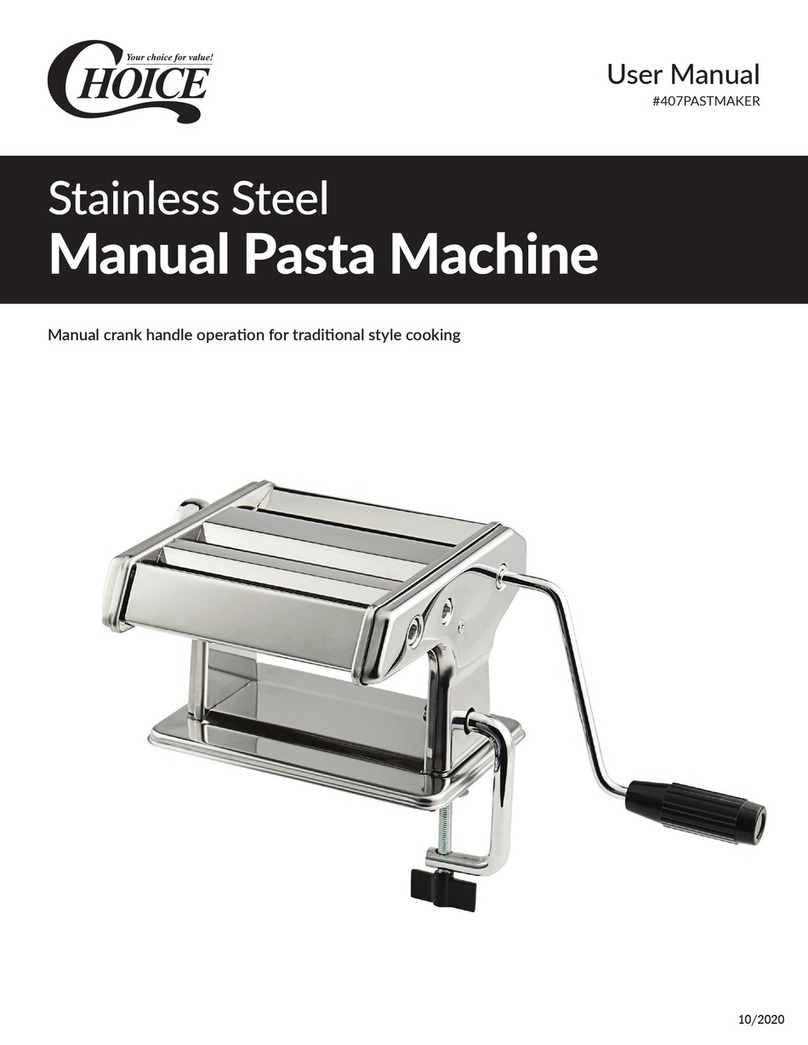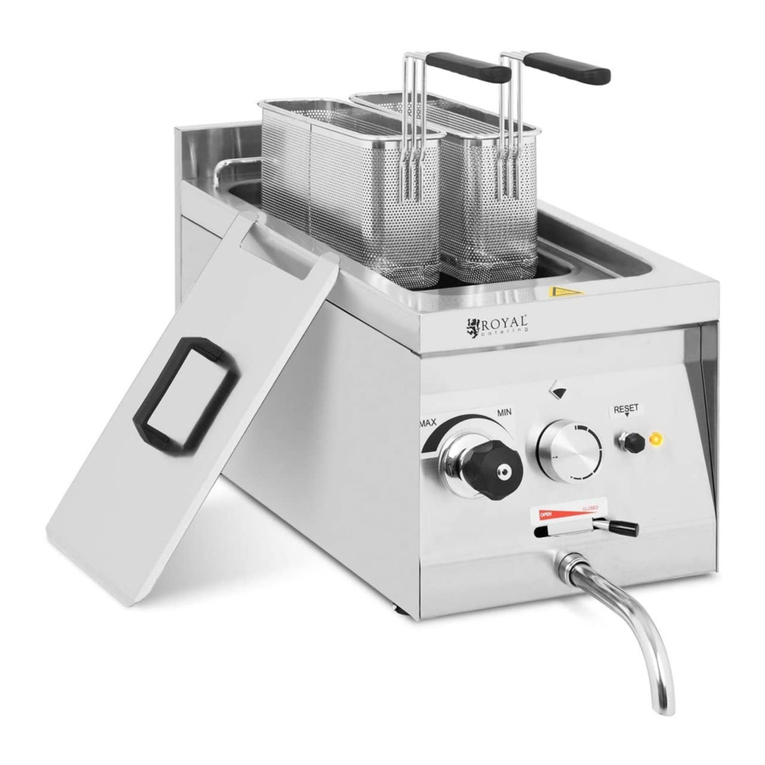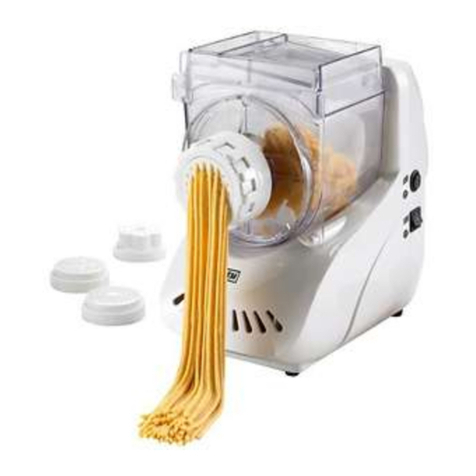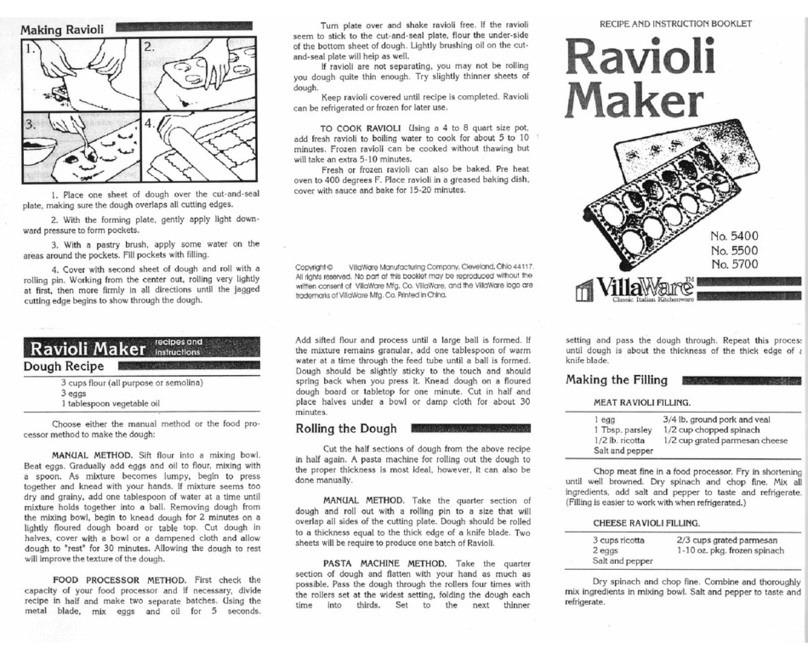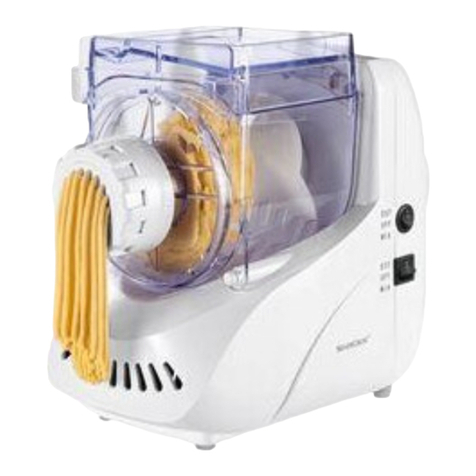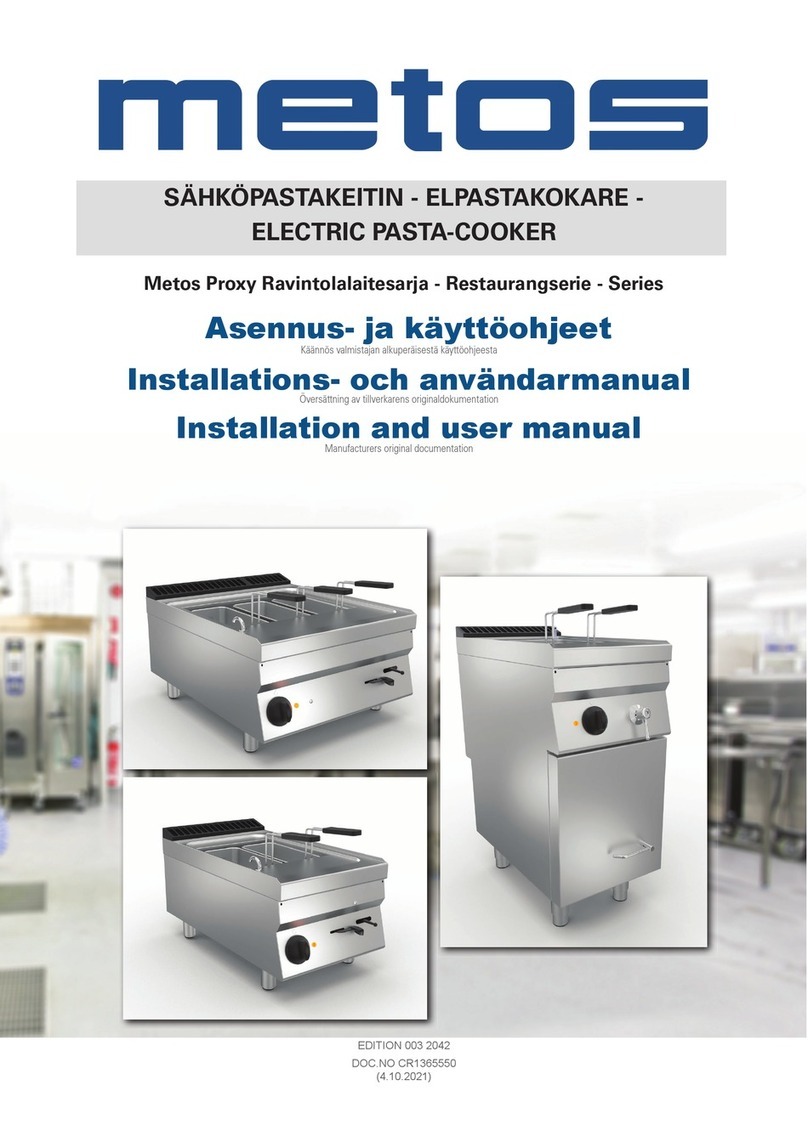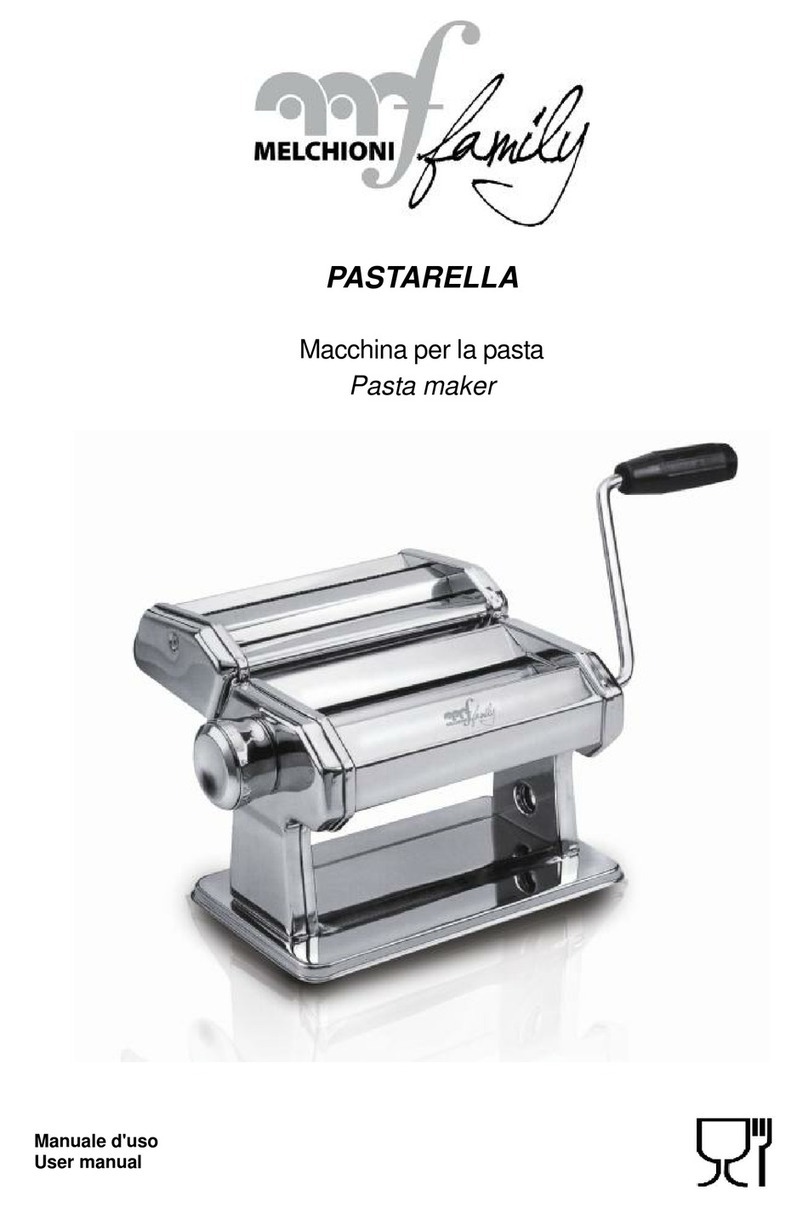Deco Chef DGPST01BLK User manual

TABLE OF
CONTENTS
Contents Page
Parts Introduction 2
Pasta Molds 3
Technical Specifications 3
Before Usage 4
How to Use 5
Assembling the Pasta Maker 5
Disassembling the Pasta Maker 7
The Control Panel and Programs 9
Flour to Water Ratio Tables 11
Pasta Making Steps 12
Cleaning the Pasta Maker 14
Frequently Asked Questions 15
Tips on Making Better Pasta 17
Maintenance and Cleaning 18
Deco Chef Warranty 22
Thank you for choosing Deco Chef products.
We hope you enjoy the delicious recipes you
make with our Pasta Maker.

Parts Introduction
1. Mixing chamber cover
2. Mixing paddle
3. Mixing chamber
4. Extrusion pipe
5. Spiral rod
6. Mold
7. Mold head
8. Mold knob
9. Base
10. Mold storage compartment
11. Cutting, cleaning, and leveling tool
12. Water measuring cup
13. Flour measuring cup
Note: The extrusion pipe (4) holds a removable white, plastic
circular washer which is indicated in the above picture by the
red arrow. This washer may be detached for cleaning. After
washing, be sure to put plastic washer in place on the extru-
sion pipe (4). The Pasta Maker cannot operate properly with-
out this piece. 2

Pasta
Molds
3
Below are the interchangeable pasta molds for
your pasta making machine
1. Large fettuccine 2. Medium fettuccine
3.Small fettuccine 4. Thick spaghetti
5. Thin spaghetti 6. Ultra-thin spaghetti
7. Udon 8. Macaroni
9. Triangular 10. Open macaroni
11. Sliced noodle 12. Ultra-thick spaghetti
13. Dumpling wrapper
Technical Specifications
Model DGPST01BLK
Rating Voltage 120V/60Hz
Rating Power 260W
Capacity 1.1lbs
Weight 9.9lbs

Before
Use
• Before the first use of this Pasta Maker be sure to read all the
instructions carefully and keep them for future reference.
• Unpack the all supplied parts to make sure your Pasta Maker
is complete with all items listed above in the Parts Introduction
and Pasta Molds. If you find damage to the components, do not
use them. Contact Customer Service Department.
• There may still be some production residue on the product,
so be sure to thoroughly clean all parts and accessories to your
Pasta Maker before its first use.
• We recommend that you keep the product packaging for at
least 30 days in case the product needs to be put back into the
box and shipped.
• Always assemble the product properly before connecting it to
the power supply to prevent damage to the product.
• Switch off the power supply before assembling and disassem-
bling.
• Ensure the Pasta Maker’s voltage rate (120V/60Hz) matches the
voltage stated on the rating label.
• Place the product on a flat, dry surface.
4

HOW TO
USE
5
ASSEMBLING THE PASTA MAKER
1. Ensure the Base (9) of the Pasta Maker is on a flat, dry surface, and not plugged
into your power supply. Find your Mixing Chamber (3) and fix it in position on the
top of your Base (9). Insert Mixing Paddle (2) onto the motor shaft, or the small
insert hole at the top of the Mixing Chamber (3). Once the Mixing Paddle (2) is
inserted into the Mixing Chamber (3), gently rotate the Mixing Paddle (2) to fix it
in place.
2. Insert the Extrusion Pipe (4) into the front opening of the Mixing Chamber (3).
3. Insert the Spiral Rod (5) into the front opening of the Extrusion Pipe (4). Fix
into place.

4. Insert your Mold (6) of choice (i.e. Udon, Spaghetti, etc.) into the Mold Head (7).
Ensure you are placing the extruding head, or Mold (6), facing downward so that
pasta drops smoothly (See instructional diagram below). Then, install the Mold
Head (7) into the Spiral Rod (5).
5. Place the Mold Knob (8) over the Mold Head (7). Tighten the Mold Knob (8) by
turning it clockwise.
6. Put the Mixing Chamber Cover (1) on the top of the Mixing Chamber (3) and
Mixing Paddle (2). Secure tightly.
Note: 7
• Make sure the Mold Knob (8) has been fixed properly and tightly.
• The dough’s extrusion time is related to the shape of the mold. The finer and
smaller the hole, the longer it takes for the noodles or pasta to be extruded. It
may take about 3 minutes for ultra-thin spaghetti to be extruded.
ATTENTION: The extrusion mold can only be changed after the Pasta Maker has
been switched off.
6

HOW TO
USE
7
DISASSEMBLING THE PASTA MAKER
Turn off Pasta Maker and disconnect from power supply before disassem-
bling.
1. Unscrew the Mold Knob (8) by turning it counterclockwise.
2. Remove the Spiral Rod (5) and Mold Head (7) by pulling them directly out of
the front opening of the Mixing Chamber (3).

3. Pull the hook connecting the Mixing Chamber Cover (1) to the Mixing Cham-
ber (3) and left the edge of the cover to remove.
4. Gently remove the Extrusion Pipe (4) by pulling it directly forward and out of
the front opening of the Mixing Chamber (3).
5. Remove the Mixing Paddle (2) by pulling it upward from the motor shaft locat-
ed at the top of the Mixing Chamber (3).
6. Remove the Mixing Chamber (3) by pulling it forward from the Base (9).
8

HOW TO
USE
9
THE CONTROL PANEL AND PROGRAMS
Confirm/Cancel
When connected to the power supply, the machine will beep and display “----“.
The Pasta Maker will enter standby mode in the following situations:
• If any function buttons are pressed, it will display “ON” and enter standby mode
if the Pasta Maker is not operated within 60 seconds.
• The Pasta Maker will stop working and go into standby mode if “Confirm/Can-
cel” is pressed during operation.
Chewy Pasta/Fast Pasta/Dumpling Wrapper
• Select the desired function. The display light will blink. The Pasta Maker is now
on standby mode.
• The Pasta Maker starts operating when “Confirm/Cancel” is pressed.
• After the extrusion process is completed, the Pasta Maker will stop automatical-
ly, and the control panel will display “OFF” and emit a beeping sound to signal
the completion of this process. The extrusion process takes about 15 minutes.

Extrude
• Press “Extrude” to remove dough that remains in the Mixing Chamber after the
noodle or pasta making extrusion process is completed.
• The “Extrude” function countdown is 5 minutes. Use this function only if water
and flour are mixed properly. Otherwise, it may cause the Pasta Maker to mal-
function.
Knead
• Press “Knead” button to mix dry flour with water. The dough will be ready in 4
minutes.
• The Pasta Maker detects whether the dough is too dry or if there are any for-
eign objects inside the Mixing Chamber and will read “E1” if this is the case.
• If display reads “E1” add adequate water and choose “Extrude” function. If the
Pasta Maker is still unable to work properly, switch off the product and discon-
nect from the power supply. Check whether dry flour or any foreign objects have
blocked the mold’s holes. After cleaning the mold, operate the product again. If
“E1” is still displayed, contact Customer Service Representative for further assis-
tance.
• Do not put any non-liquid ingredients except flour in the Mixing Chamber. Eggs
must be mixed with water before pouring into the Mixing Chamber.
• Do not open the Mixing Chamber Cover, unscrew the Mold Head, or touch the
Spiral Rod while the Pasta Maker is operating to prevent injury and damaging
the product.
10

HOW TO
USE
11
FLOUR TO WATER RATIO TABLES
Fast Noodle and Dumbling Wrapper Measurements
Flour
(Leveled Cups)
Water
(Ounces)
Vegetable Juice
(Ounces)
Water and Egg
(Ounces)
1 2 2 2.3
2 3.4 3.4 3.7
3 5.4 5.4 5.7
Chewy Noodle Measurements
Flour
(Leveled Cups)
Water
(Ounces)
Vegetable Juice
(Ounces)
Water and Egg
(Ounces)
1 1.7 - 2 1.7 - 2 2 - 2.3
2 3.1 - 3.4 3.1 - 3.4 3.5 - 3.7
3 5.1 - 5.4 5.1 - 5.4 5.6 - 5.7
Recommended Flour to Water Ratio Table
• The ratio of water to flour should follow the table as closely as possible.
• Add water slowly and evenly.
• The only dry ingredient that can be added to the Mixing Chamber is flour. Oth-
er dry ingredients will cause the Mixing Chamber to not function properly.
• The Mixing Chamber will rotate clockwise to extrude the noodles, and it will
rotate counterclockwise while mixing the dough.
• Eggs must be mixed with water before adding into Mixing Chamber.

• Add extra 0.17 ounce of water to the recommended amount when making
ultra-thin spaghetti for a better result.
• The maximum amount of dry flour that can be added to the Mixing Chamber
is 3 cups (1.06 LBs). The maximum amount of water is 5.4 ounces (plus/minus
0.17-ounce deviation subject to humidity of flour).
• The minimum amount of dry flour that can be added to the Mixing Cham-
ber is 1 cup (0.35 LBs). The minimum amount of water is 2 ounces (plus/minus
0.17-ounce deviation subject to humidity of flour).
• Carefully add flour and water according to the amounts listed in the tables on
Page 11. Incorrect amount of fluid or flour will damage parts of the Pasta Maker.
• Do not knead dough until flour and fluid are mixed properly when using manu-
al function.
• This product has an intelligent dough making program that will stop automat-
ically after a certain period. This function is to let the product’s motor cool down
as continuous use without stopping may damage the product. If this occurs,
please wait 20-30 minutes to resume the noodle making process.
Pasta Making Steps
1. With the product disconnected from the power supply, open the Mixing
Chamber Cover.
12

HOW TO
USE
13
2. Measuring flour: Do not heap flour (A). Use a flat edged tool to level the flour so
that it is a flat cup (B).
3. Measuring water: After pouring water into measuring cup, place the cup on a
flat, stable surface. Do not hold it in your hand to view the contents level. Pour
in liquid until it is just under the measured line. Look at the measuring cup with
your eye level to the graduation to achieve accurate measurement.
4. Pour flour into Mixing Chamber.
5. Fix the Mixing Chamber Cover back on the Mixing Chamber. Connect product
to power supply. Press the desired function button and press “Confirm/Cancel”
button. When the Mixing Paddle starts mixing, pour the proper amount of water,
according to the Measurement Tables on Page 11, into the Mixing Chamber.

6. After about 10 minutes the product’s alarm will sound signaling the end of the
noodle/pasta mixing process.
Tips:
• Ensure Mixing Chamber’s slot (where water is poured) remains clear.
• If making egg noodles, always mix eggs with water before pouring the mixture
into the Mixing Chamber. Do not add egg directly into Mixing Chamber.
• Do not use blended vegetables/pulp. Use the juice only.
Cleaning the Pasta Maker
1. Disassemble all parts (see Page 7) and dry in open air or for 2 hours in a refrig-
erator to make it easier to remove sticky flour.
2. When the parts are dry, use the Cleaning Tool to clean the Mixing Chamber,
the Mixing Paddle and Mold.
14

FAQs
15
FREQUENTLY ASKED QUESTIONS
1. Why is the Pasta Maker not operating?
- The product is not connected to a power supply or the plug’s contact
is weak.
2. Why isn’t the Pasta Maker extruding pasta?
- There may be too much or not enough liquid.
- If there is too much liquid, remove the dough from the Mixing Cham-
ber, tear it into small peanut-sized pieces, add 0.07 LBs of flour
and press the “Extrude” function.
- If there is not enough liquid, remove Mold and replace with another
Mold. Add adequate water and press “Extrude” function.
3. How many types of noodles or pasta can be made using this Pasta Maker?
- 13 different Molds are provided to make 13 varieties of noodles or pasta.
Eggs, different fruit or vegetables juices can be added to make different
flavors.
4. Why is dough still left in the Mixing Chamber after the extrusion process?
- The dough is either too soggy or the flour was damp. For best results,
damp flour is preferred. Resume making pasta after adjusting the water
and flour ratio according to the Measurement Tables on Page 11.
- The Mixing Chamber, Mixing Paddle, or Mold were not washed prop-
erly or still contain flour from the previous use. Please wash
them properly to ensure the correct ratio.
- Water was added in the wrong order or damp flour was used.

5. How do I use the flour measuring cup correctly?
- Using the flour measuring cup, scoop one full cup. Use a flat edged
tool to level the excess flour on the top of the cup. This level cup serves
1-2 people (around 0.35 LBs).
6. Why are my noodles or pasta cracked or uneven?
- Uneven mixing of flour may result in cracked or rough textured noo-
dles or pasta. Add eggs or adequate cooking oil to make the noodles or
pasta smooth.
- If possible, tear the noodles or pasta into small, peanut-sized pieces
and press “Extrude” button.
- If there is inadequate liquid, remove existing Mold and replace with
another one. Add adequate water and press “Extrude” function. Repeat
this process a few times until pasta is smooth.
7. How do I remove the flour that is stuck in the Mold?
- Let the flour in the Mold dry. The dried flour will fall off easily when the
Mold is knocked on a hard surface.
8. Are there any special requirements for the type of flour used in noodle or
pasta making?
- We recommend using medium or high gluten flour that does not
have a high water content.
9. What do I do if there is flour in the Mixing Chamber after the noodle or pas-
ta making process?
- Switch off the Pasta Maker. Take the remaining dough and lump it
together before putting the dough ball back into the Mixing
Chamber. Press the “Extrude” button to recommence the noodle or
pasta extrusion process.
16

TIPS ON MAKING
PASTA
17
10. What do I do if the extruded pasta is hot and sticking together?
- Overly sticky noodles may be related to too much water in your mix-
ture. Sprinkle some flour on extruded noodles or pasta immediately
to make them springier and smooth before cutting them into the ap-
propriate length.
11. Why do the noodles or pasta break?
- Brittle noodles or pasta could be due to inadequate liquid. See the
Measurement Tables on Page 11 for the recommended water
to flour ratios.
Tips on Making Better Pasta
• Check to make sure the dough is evenly kneaded, slightly moist and forms a
soft, malleable dough. The dough should not be too dry or too moist.
• The dough is too dry if it feels powdery, grainy and breaks into small chunks
during extrusion process.
• The dough is too moist if large chunks of dough remain stuck to the Mixing
Paddle. Add flour by the teaspoon until it forms a smooth, malleable dough that
doesn’t stick to the sides or the Mixing Paddle. Adding a small amount of olive oil
to the pasta dough will help the dough slide through the Mold opening better.
• You can use both normal household flour as well as wholegrain flour, glu-
ten-free flour, or flour made from durum wheat semolina to make the noodles
or pasta. Please note that different types of flours will require different amounts
of liquid.

MAINTENANCE &
CLEANING
• Add liquid bit by bit for best results. Write down the amount of liquid used for
your favorite, unconventional flours so that you can use the same measurements
in the future.
• Vegetable juices from spinach, carrots, or tomatoes are suitable for making your
noodles more nutritious and colorful.
• Sprinkle flour on your pasta immediately as it comes out from the Mold open-
ing and place it separated on a smooth floured surface to dry. This will prevent
the noodles or pasta from sticking together.
• Fresh pasta cooks faster than dried pasta from a supermarket does, therefore
usually 2 to 4 minutes is enough. The thinner the pasta, the shorter the cooking
time. Check the pasta frequently until they are cooked properly.
• Fresh pasta can be kept for 1 to 2 days in the fridge while fresh pasta that is
frozen after extrusion can be stored as long as 6 months. Lay the pasta out to dry
for at least 1 to 2 hours before putting it in the fridge or freezing it.
Cleaning and Maintenance
Before using this electrical product, the following basic precautions should
always be followed:
- Before inserting the main plug into the socket, check whether the
supply line voltage and current rating follow the rated electric
parameter shown on the label.
18

MAINTENANCE &
CLEANING
19
• Ensure the product’s wiring is properly grounded.
• Switch off the power before assembling or disassembling.
• Do not substitute extension cords for permeant wiring.
• Ensure all packaging materials and any promotional labels or stickers are re-
moved from the product before the first use.
• This product should be used for preparation of food as described within the
instructions.
• Always inspect the product before use for any noticeable signs of damage. Do
not use if damaged or if it has been dropped. In the event of damage, or if the
product develops a fault, contact Customer Care/Service Center.
• Always assemble the product properly before connecting it to the power supply
to prevent damage to the product.
• Do not use any accessories or attachments with this product other than the
parts and accessories that come with it.
• For indoor use only.
• For domestic use only. Do not use for commercial purposes.
• The dough is too moist if it becomes stuck to the Mixing Paddle. Add some
flour to make the dough malleable. The dough is too dry if it is powdery, grainy,
and breaks into small chunks during the extrusion process. Add more liquid by
the teaspoon until the dough is malleable.
Table of contents





